
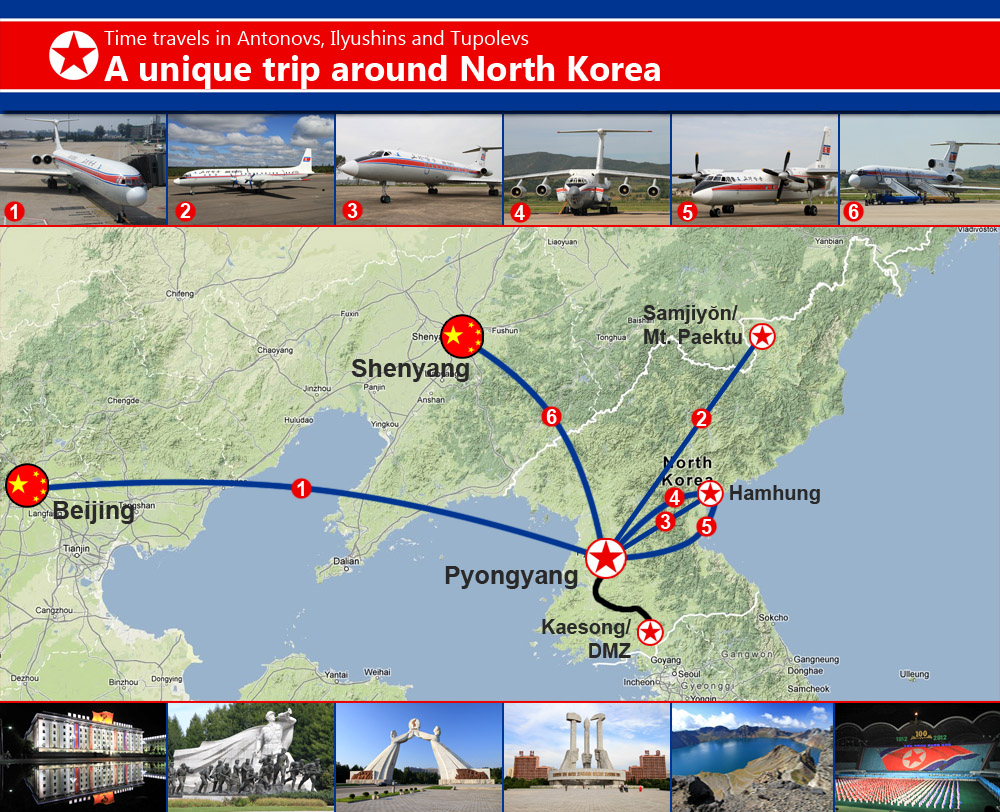
Following the invitation from a German aviation enthusiast late last year, I convinced myself to join a one-week tour through North Korea, despite many concerns brought forward by family and friends. The relatively new English tour operator “Juche Travel Services” offered a one-week tour around the country, focusing on flights on the popular Soviet airplanes, but also on sightseeing in Pyongyang and beyond.
On September 8, the big day had finally come: 40 aviation enthusiasts from around the world, almost bursting with sheer anticipation, gathered in a hard to find North Korean restaurant in Beijing for a pre-tour “welcome dinner”. By that time I’d already spent two packed weeks travelling through Japan and might have been a bit tired; but the outlook of the adventures lying ahead didn’t take long to get me all excited again!
After some small talk, and the handover of our North Korean visa, we were invited to take our seats on the huge round table and enjoy a wide range of Asian and Korean dishes.

But that wasn’t all! No sooner had we finished eating, some gracious North Korean musicians in evening gowns stormed the stage. Whoever thought that just one of the usual tedious folk music presentations would follow was immediately proved wrong. The petite girls put on their electric guitar, jumped behind the drums and keyboard and started rocking the room with unbelievable energy. The first, but not nearly the last surreal experience this trip!

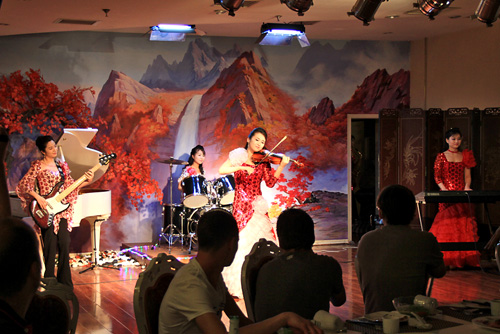
After that night we were all even more excited about the week that was to follow. All ready? Almost. Before I start with the report, I want to include a very brief summary of the recent North Korean history, which might conduce to a better understanding here and there later on.
The entire Korean Peninsula was occupied by the Japanese since 1910 and suffered badly from their suppression of the local culture. On August 15, 1945, Japan had finally capitulated under pressure from the Allies, and handed over the northern region of Korea to the USSR, and the southern region to the United States. The Soviet Union had a great interest in North Korea as a buffer to Japan, which quickly became an ally of the United States. Accordingly, the USSR was eager to shape “their” North Korea after their communist ideals.
Following a UN resolution, the USSR withdrew its army from North Korea in 1948, while the U.S. remained present in the South to this day – one of the main points of conflict from the North’s point of view. When elections were held in the south and the business of government was transferred from the Americans to the South Koreans, the North responded to this with the establishment of the Democratic People's Republic of Korea (DPRK) on 9 September 1948, with Kim Il-sung to become its first president. Both governments have ever since seen themselves as the legitimate rulers of (whole) Korea.
Following his proclaimed “Juche” ideology, according to which it is the central task of every state to ensure the political, economic and military independence of the country, Kim drove North Korea into an ever greater isolation. This worked out pretty well in the beginning and the North overtook the South in economic terms (especially thanks to its heavy industry), which helped Kim gain a godlike popularity among his people. However, the growth eventually stagnated more and more. Because of the little arable land, it became increasingly difficult to grow enough food to support the whole population, culminating in a catastrophic famine in the 1990s. Lack of food is still a huge problem even today, but at least the international aid that had been refused for a long time is now being accepted.
Kim il-sung was followed by his son Kim Jong-il in 1994, who replaced the “Juche” ideology by the slogan “Army First”. While the isolation slightly degraded and made way for small beginnings of a free economy, a huge part of the resources were spent on military power and development, preparing the army for the war the country still sees itself taking part in.
2011, after Kim Jong-il's death, his son Kim Jong-un came to power, which brings a lot of uncertainty with it. While it is expected that the new ruler follows the old line of the dynasty and will need to mark his presence in the first few years, observers and experts of the country have started to report of unprecedented openness and optimism in the past one to two years.
Flying the IL-62 from Beijing to Pyongyang
In the midst of this uncertain situation, our group assembled early at Beijing’s huge airport the next morning, to make its way to the hermit kingdom. And we weren’t the only ones! The Arirang Mass Gymnastics Festival, which will be featured later on in this report, drew large crowds of tourists to North Korea. In total, Air Koryo sent two IL-62, one Tu-154 and one Tu-204 to Beijing on that day alone. Even the lengthy 2-hour check-in process this resulted in, couldn’t take away any of the excitement!

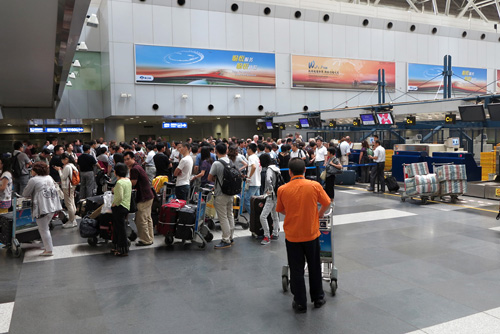
It took until 30 minutes before departure until finally every member of our group was checked in. A quick run through security followed, and then we were good to go!

The fact that half the Air Koryo fleet was in Beijing had us fearing we wouldn’t get the planned IL-62 for the past three hours, but here she was, at our gate! The 33-year-old beauty with the registration P-885!

With a delay of about 20 minutes the aircraft was pushed back, we listened enthusiastically to the start-up of the four Soloviev D-30 engines, and after a brief taxi and a very short wait at the runway (for Beijing standards), the IL-62 finally took to the hazy Beijing skies!
For an adequate background noise, open this great video of our take-off made by my colleague Simon de Rudder, sitting a few rows behind me!
http://www.youtube.com/watch?v=X-bb2MXtmhQ&hd=1

View from my seat in the rear cabin (separated business class in front). The aircraft was filled to the last seat!

Who thought darkened windows were a novelty of the B787 hasn’t thought of Russian ingenuity! In addition, a look at the business class...

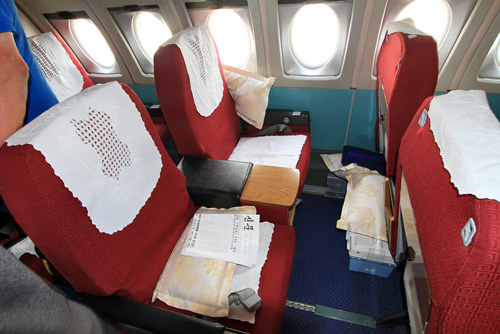
More impressions of the cabin
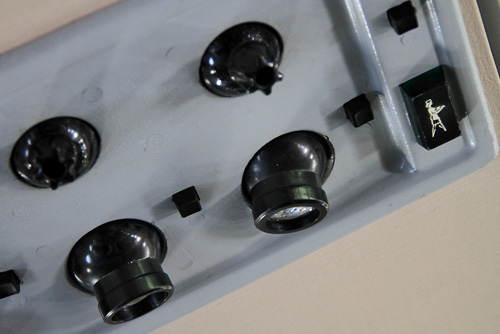
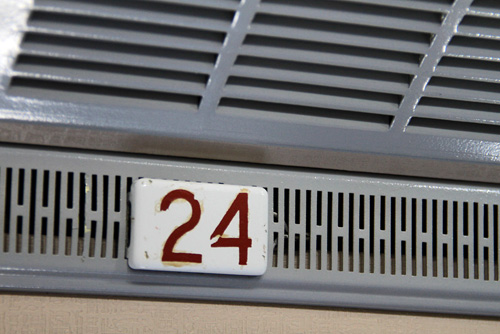
The flight time of 80 minutes left barely enough time to serve all 180 passengers, and the food was distributed very quickly
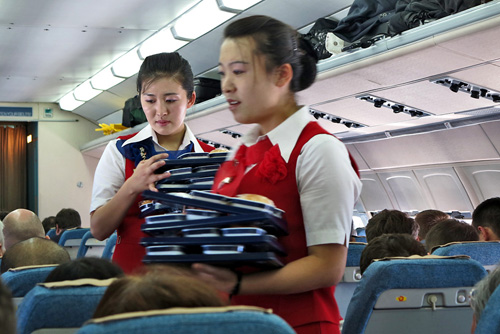
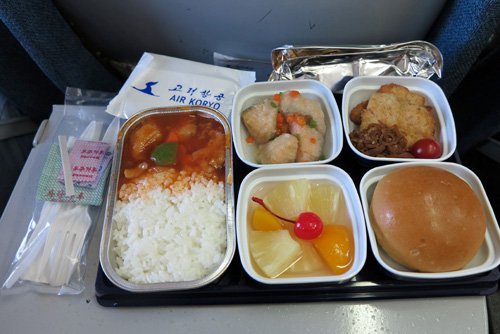
Mmmhm, now how do I make an appropriate bridge to the next picture! Nooo, the food really wasn't all that bad! :)

We had barely swallowed out last bite when the nose of our all-metal aircraft was lowered, speedbrakes extended, and we set course for Pyongyang’s airport. Previously, when crossing the border, an announcement in honor of the "great leader” was made and the national anthem played

A quarter of an hour before landing a loud *clunk* sound was heard, and the landing gear was extended (a practice that was repeated on later flights). Eventually, we turned over attractive landscapes onto the final approach to the 4,000 meter-long runway 19 of Sunan International Airport in Pyongyang. Here we are on finals, my colleague hitting the jackpot with this photo!

After landing and an eternally long taxi (those interested, look up Pyongyang’s airport layout on Google Maps – only the far runway remains in use) we finally arrived at the main apron. Now we were allowed, one after the other, into the cockpit to take a photo – something which takes quite a lot of time with 40 enthusiasts! Just when it was about my turn, the session was terminated, as the fourth airplane from Beijing was about to land and they wanted us crazy guys to leave the apron. It obviously wasn’t really my day, and so another outside photo will have to do.

Welcome to Pyongyang! Unfortunately, the old "Soviet-style" terminal was demolished a few weeks earlier, and had to make way for a modern-looking temporary building. Behind the blue planks on the left, construction work for the new terminal is starting.

Yummy yummy, a look at the static display! From front to back: Tu-204-300 P-632 (built 94, with Air Koryo since 2007) , the Tu-154B P-561 (delivered to Air Koryo directly in 1976), then the Tu-154A P-552 I in which should fly a week later (delivered directly to Air Koryo in 1983), followed by the IL-62M P-885 (1979). Knowing observers have of course already spotted the stranger in the background: The IL-62M P-886P, which was transferred from Cubana (ex CU-T1280) to Air Koryo only some weeks before. Whether it will fly for the airline or just be used for parts couldn’t be determined. But it is rumoured that Air Koryo will soon announce the purchase of new aircraft, and the IL-62 might be withdrawn from international service starting next year.
Currently, the Air Koryo fleet looks about as follows:
- 5x An-24 (2x -24B active, 2x -24RV active, 1x -24B stored)
- 2x IL-18 (1x pax, 1x cargo)
- 5x IL-62 (2x pax, 2x VIP, 1x ex Cubana)
- 3x IL-76 (at least two active)
- 2 Tu-134B (only one seen)
- 2x Tu-154 (1x-154B, 1-154B-2)
- 2x Tu-204 (1x -100, 1x -300

A look at the small temporary terminal of Pyongyang (pictured on a different day, on Saturday it was brimming with people). Immigration itself was quick and easy - for the subsequent security check however, we had queue for about 30 minutes.

Here our mobile phones were collected and stored at the airport for a week. Apart from those, the only thing else that bothers the North Koreans, are GPS. Therefore I left my beloved GPS watch in Beijing, and could truthfully answer “no” even the fourth time an official asked me if I had any GPS device. After critically eyeing my laptop and my camera for a few seconds, I finally entered this strange country without any further losses.
In front of the terminal, we were greeted by our four guides who doubled as our companions, tour guides and observers for the next week. These were two men and women from 21 to 35, who had been trained for four years at the University of Tourism, had profound knowledge of their country and spoke pretty decent English. Dealing with them was really enjoyable and warm, marked by a lot of laughing, and after a few days we had become friends. They also answered all our questions about the construction of their country, their lifestyles, etc. – just our cynical remarks about some of those things weren’t really appreciated.
They never really interfered with our photography plans either – they just prohibited taking pictures of military installations or personnel, but apart from that, we were pretty free about what to shoot.
Two buses were waiting for us. A group of 20 people each was assigned to a bus, and joined by two guides each, we set out for the city center about 30 minutes away. On the side of the road, the “great leader” already welcomed us :)

The road is lined with several monuments. Here the Immortality Monument, which is actually dedicated to Kim Il-sung and located on the road to his mausoleum, but now carries Kim Jong-il’s name as well.

Just ahead is the next impressive sight: the North Korean triumphal arch, which is modelled after Paris’ version but tops it by three meters. It was inaugurated in 1982, commemorating the 70th Birthday of the “Great Leader”. The number 1925 represents the propagated year when Kim Il-sung started the resistance against the Japanese, and 1945 the year when the Japanese surrendered.
In the background, Pyongyang’s TV Tower can be seen.

After these impressions we continued to the hotel - but even this was quite striking! The Koryo Hotel with its two 143-meter high twin towers was built in 1985, as a status symbol for the country.

While the hotel is considered to be 5-star in North Korea, I would personally rate it somewhere between a 3 and 4-star. The suite rooms had a separate living room plus a bathroom, which was up to Western standards. Oh, and we got a great view of Pyongyang from the 20th floor for free too!
(The photo’s also busting the myth that Pyongyang is completely dark at night due to power shortages)
By the way, here's a little room tour video of my room :)
http://www.youtube.com/watch?v=Pz4MhhWPtPE&hd=1

Sightseeing in Pyongyang
I’m trying to provide a coherent overview of the capital in this section, while in reality, the pictures were shot during the whole week – be it on dedicated sightseeing days, before or after the flights or even just through the bus window…
First, an overview shot of the center of the metropolis of 3 million people, taken from the Juche tower. The Taedong River divides the city in two, and not surprisingly it’s the three big hotels that dominate the skyline. On the far right, the TV tower can be seen again.

Of course, the portraits of the revered leaders are ubiquitous: Left the "grandfather" Kim Il-sung ("Great Leader") who started it all (always shown in a suit), right his son Kim Jong-il ("Dear Leader", in fashionable garb) who deceased in 2011.

On arrival after a delicious dinner at the revolving restaurant on the roof of the Koryo hotel, we set out for a spontaneous night stroll through Pyongyang. First stop: The Grand Theatre - thankfully with perfect photo-puddle! :)

The Mansudae Apartment Complex with its modern building style didn’t really fit into our mental image of Pyongyang. The futuristic urban living area was inaugurated only this year, marking the 100th Birthday of the "Great Leader"...

Not far from our hotel, Pyongyang's main train station: From here trains to all parts of the country depart; some even go to Beijing (several times a week) and as far as Moscow, 10’000 km away (twice a month).

At the central square in Pyongyang, named Kim il-sung Square (what else?), some beautiful buildings can be admired. Here, the building of the Ministry of Foreign Trade (wondering how much work they have?). On its façade it is adorned with a huge flag of the Korean Workers' Party; consisting of hammer, sickle and brush - representing industrial workers, peasants and intellectuals, which are regarded as the three main pillars of the working community.

Dominating the famous place is this massive building. However, unlike in normal cities, it is neither a government nor a religious palace – rather, in perfect alignment with the communist idea, it serves the people. The Great People’s Study Hall was built in 1983 and doubles as the national library as well as a community college.

On another day, we got a tour of the building. At the entrance we were of course greeted by the “Great Leader”, and the two guys were also present at study rooms' walls. The staff were proudly demonstrating us their school desks featuring fancy mechanisms to adjust height and tilt, too ... ;)


The highlight of the visit, however, was the view from the large roof terrace on the sixth floor: The view extends over the Kim Il-sung Square across to the Tower of the Juche Idea - it measures 170 meters and is crowned by a 20 meter high red torch. It was also built in 1982 - whose 70th birthday this was should be clear by now... :)

Of course we also visited the tower itself on another day, which also includes the symbols of the North Korean Trinity ...


The view from up above is breathtaking! First, a look at Pyongyang's futuristic side: once more the Mansudae Apartment Complex, while in the back Pyongyang's tallest and most prominent building can be seen: The Ryugyong Hotel, unfinished for years.

“Our” Koryo hotel looks pretty stuffy and old in comparison!

A view of the residential area on the east bank of the Taedong River. In the distance you can spot the May Day Stadium, the largest stadium in the world featuring 150’000 seats. It’ll play a role in this report a bit later on, too!

On that occasion, a few more impressions of houses (one is tempted to say, housing batteries) in the capital






As a brief interruption from the city life we’re now visiting the circus! Yeah, there was even time for that in our jam-packed tour program. Together with a few thousand soldiers we enjoyed great North Korean entertainment for 90 minutes. The artistic performances were world-class, some have even won the Monte Carlo Circus Festival I believe. Unfortunately photography was officially banned, so it had to be done in secret ...

Well, yeah. Besides all the outstanding performances, there were some that took a little getting used to for Western eyes. Pet lovers should maybe close their left eye and continue reading below. But at least the baboons looked as if they were having fun on the ice (the skinny bruin definitely not). The lady, who for three minutes balanced a glass on a broomstick all while hanging on a rope was great again, though!

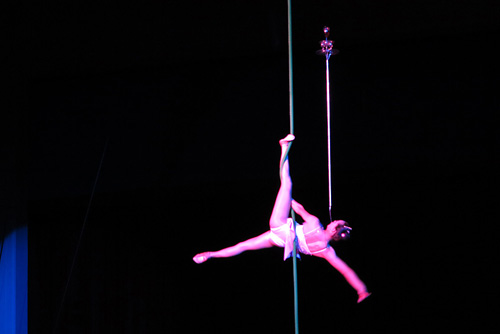
Let's continue with something more beautiful! Unarguably, what North Koreans do best are monuments; and this is one of my favourites. Located on the main road leaving Pyongyang to the south (i.e. in the direction of South Korea), the Reunification Monument is standing. It’s made up of two exactly identical statues of Korean women in traditional dress holding together a board with a map of a united Korea.

Neeeeext! To anyone who has been paying attention, the symbolism should be familiar. Other notable facts: It’s the Party Founding Memorial, and it was built in 1995 to mark the 50th anniversary of the Korean Workers' Party.

Finally we were able to get a bit closer look at the Ryugyong Hotel. The construction of the (then the world's highest) hotel began in 1987. However, it was never completed because of various problems, and its grey concrete shell towered over the city like a massive eyesore for many years. Only recently, with the money of Egyptian Orascom company which is also responsible for the construction of a North Korean mobile network, the façade was completed and work on the inside is said to continue.

The next place to visit is hard to beat in terms of symbolism and propaganda importance: In 1968, the North Korean Navy captured the American spy ship USS Pueblo, which was cruising along the coast of the communist country. The soldiers on board were sent to torture camps, but were released after eight months following a (faked) apology from the U.S. government. The Pueblo remained in North Korea though and is the only ship in the U.S. Navy which is in the hands of a foreign power.

Of course, the Pueblo, which is now anchored in the Taedong River, was turned into a major tourist attraction, doing its very best to hit you with a propaganda overdose. Preppy female officers with chirpy voices (left, on the right one of our guides) tell tourists the North Korean version of the Pueblo incident – while I believe it was clear to anyone involved that our group was far more interested in obtaining pictures of Madame in uniform than of the ship itself. Anyway. After touring the ship’s secret rooms, we just had to endure a 10 minute propaganda film, and then we were good to go again.


The next place visited was far more interesting again! We dove down into the underground world of the legendary Pyongyang Metro!



The system consists of two lines, which at a depth of 100 meters run below the city center west of the Taedong River, and whose tunnels are said to double as bomb shelters, too. At least the five stations we visited were richly decorated with monstrous chandeliers on the ceiling, detailed mosaics on the tunnel walls, and of course statues of the national demigod. The rolling stock was taken over from the Berlin subway, but received a new color scheme.


Since we're on the subject of public transport, here are some more impressions from the city’s transit network. Since 1962, Pyongyang has an extensive trolley-bus network. While the numerous antique busses in all degrees of decay ploughing the city’s streets were obviously at the center of everyone's attention, it must be noted that an increasing number of top modern-looking models can be spotted, too. By the way, each star painted on a vehicle represents 50,000 kilometers travelled (for example the yellow bus below).





The trams on the other hand seem to consist only of very old Czech Tatra sets, which were either built directly for Pyongyang, or were taken over second hand from Leipzig, Dresden or Magdeburg in Germany. On a separate line, which unfortunately we didn’t get to visit, old trams from Zurich are cruising about, too ...



Arirang Mass Gymnastics Festival
On Sunday evening, we were treated to a very special spectacle: the visit of the Arirang Mass Gymnastics show in the already mentioned May Day Stadium. Here we are!

The 90-minute show is loosely based on the Korean folk song Arirang, which is about a love story. Mass gymnastics involving a total of 100’000 dancers tell not only the love story, but also include references to the North Korean history and celebrate the most important technical achievements.
Here is the beginning of the story, starting with a sunrise - the sun at the same time also stands for Kim Il-sung.

Almost as spectacular as the synchronised dancing on the lawn is the background: It is made of 30,000 students who create ever changing mosaic images by holding coloured plates up in the air. Of course the national flag is one of them.

The love story is interwoven with the history of the country - I think this scene treated the invasion of Japan, which separated the two lovers.

Many of the mosaics pay tribute to the country’s infrastructure: This one here’s unmistakably about modes of transport, and clearly includes Air Koryo’s IL-62!

From time to time it gets very cheesy ...

... before military precision returns (all soldiers were played by actors though). Impressive!


Wow!
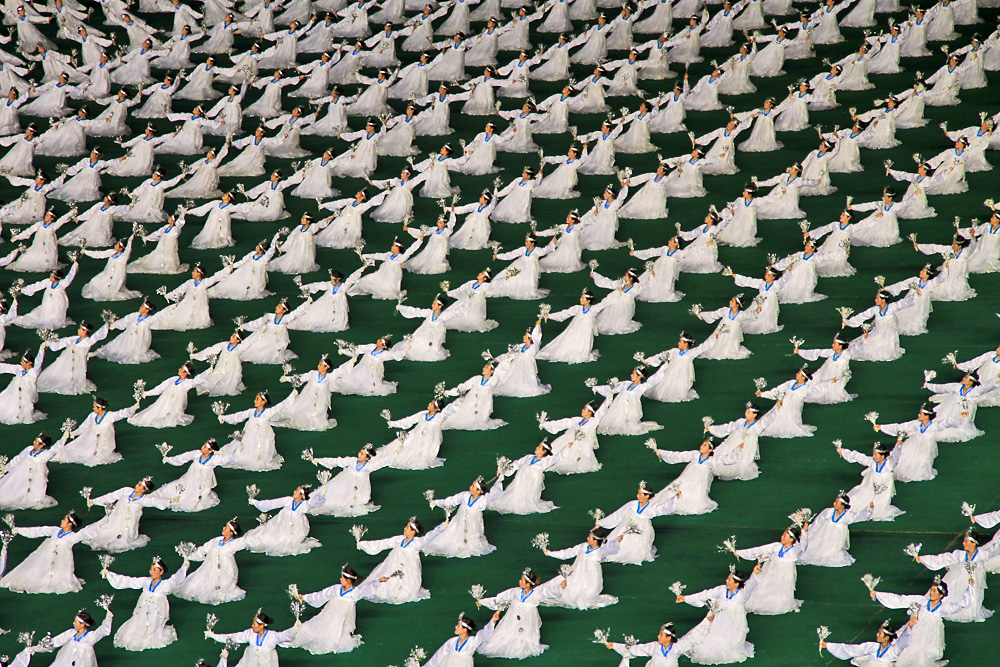
Time for the ‘grande finale’, showing Korea as the center of the world (they were kind enough to include some peace doves in there, too though)!

Under a bombastic firefork, all 100‘000 dancers present themselves to the audience. The whole show was really something of the best that I have seen in my life. And even though the country is unarguably plagued by huge problems – such an evening can really make you forget it for a while!
In short, if someone is planning to go to North Korea, I would certainly recommend to do so during the Arirang festival (usually in August / September)

The whole beauty of this spectacle can barely be captured in still images. Therefore I recommend to anyone who’s interested to take a look at my video here, in which I stitched together a few impressive sequences.
http://www.youtube.com/watch?v=vk3Pncllt8E&hd=1
Daytrip to Kaesong and the DMZ
After Pyongyang is now covered, I’ll continue chronologically. Back to Sunday, our first day in the country. A 2-hour bus ride over eerily empty (and unnervingly bumpy) highways took us to the demilitarized zone (DMZ) on the border to South Korea; and to the border city of Kaesong – the country’s fifth largest city with 300’000 inhabitants.

A deserted access road cuts through the endless rice and soybean fields

A hamlet along the route

More impressions of buildings and towns along the route – the one on the lower left being a rest stop restaurant which we briefly visited

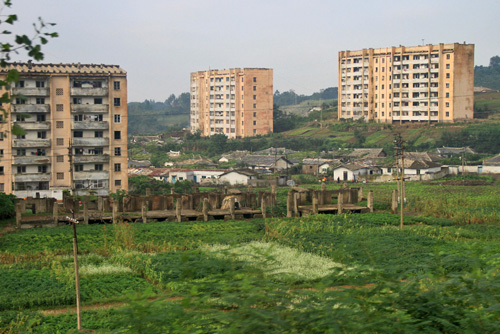




The center of our visit: the border area at Panmunjom. The border between North and South runs through the center of the blue huts, which are therefore often used for conversations between the two governments. The massive building with a dozen cameras on the roof is the South Korean visitors center.

7
Left is a picture from inside the barracks, one of our Americans sitting on the South Korean side (right), one of the Dutch guys on the left in North Korea. The line passes through the center of the table, where the microphones are.
On the right you can see the monument that carries Kim Il-sung's signature, with which he’s supposed to have signed a document for the desired reunion on the day before his death (07/07/94). Of course, the panel is 8.7 meters wide and the whole monument is 9.4 meters long (representing the death date of 8/7/94), and 82 Kimilsungia flowers (yeah, they exist!) carved into the stone represent the “Great Leader’s” age when he died.


After the trip to the border, we visit the city of Kaesong, which is dominated by a giant at Kim Il-sung statue on a hill



The city was richly decorated for the National Day (September 9) - and as usual, children (and often adults and soldiers, too) joyfully waved at us!


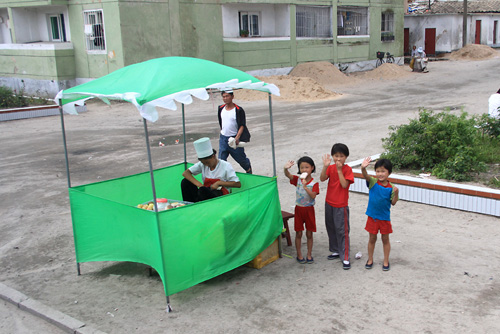
Kaesong was the center of medieval Korea under the rule of the Koryo Dynasty (Koryo -> Air Koryo -> Korea) and therefore has a distinct cultural and culinary history. Once again we enjoyed a varied and tasty meal.

During our stay most clouds had disappeared, and I was able to get some more beautiful impressions of the countryside during our drive back to Pyongyang.



Again and again we drove through hilly and mountainous regions, which are also one of the main reasons for the continuing food shortages: Only 18% of the land area is flat enough to be cultivated and the rather arid climate during most of the year isn’t conducive to farming either. This leaves me with the impression that, regardless of how good the “Great Leader’s” intentions with his Juche ideology of isolation and self-sufficiency may have been, he simply picked the wrong country to pull it off!
But yes, the scenery is absolutely beautiful!


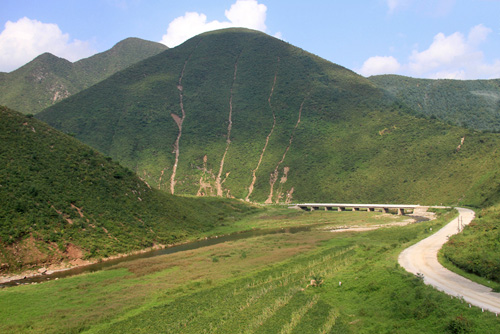

Alrighty, now you’ve waited long enough: Fasten your seatbelts, here comes the flying part of the report!
Heading for the mountains in the IL-18: North to Mount Paektu

6 o’clock wake-up call (once again ...), 6:30 breakfast, 7 o’clock departure to the airport. During the half hour drive through dense fog we wonder if our old lady would be able to fly in these conditions. But the closer we get to the airport, the more the sun peeks through the clouds - and once we’ve passed the lax security check and catch a glimpse of the apron, the 44-year-old Russian beauty is sitting there in the best morning light!

Soon after, everything is ready for boarding. Together with a Belgian tour group we climb up the stairs in the back of the Il-18D P-835.


Seat reservations worked more or less, and I could enjoy my desired view of the huge four-bladed propellers, measuring 4.5 meters in diameter. Soon the four Ivchenko AI-20M-turbines had been started, and after the usual 10 minute taxi time we climbed into the hazy morning sky. What a great feeling!
Here's a video from another tour member: http://www.youtube.com/watch?v=A6PX6M0oyEM

Simply beautiful!

Cabin View

And a few more features, including speed and altitude displays in the Business Class cabin in the rear of the aircraft. Oh and I’d love to have these folding seats in Western airlines, too!




Soon again the relatively short descent began, as we aimed for Samjiyon Airport, with a considerable elevation of 1’400 meters.

The landing was unfortunately totally backlit, hence no photos. Here we are already on the small apron at the end of the runway, with a view of the VIP terminal

We were in no hurry to leave the aircraft though, as every group member got to have a look in the cockpit. What a great pleasure!

Looking under the beauty' wings...

…and admiring the modern ground equipment :)

The 40 aviation enthusiasts were free to roam around and photograph the classical Russian from all angles, with ever growing grins on their faces. But that wasn't enough! Our organizers asked the crew to carry all cargo bags out of the picture and persuaded the driver of the boarding stairs to bring his vehicle in position for us photographers. And here we are, in North Korea, at a military airbase, with tested MIG engines howling in the distance, shooting pictures of a rare aircraft from the boarding stairs. Am I dreaming?

The result: The best possible picture one could hope for!

While the others were still taking turns at the stairs, I went looking for other interesting perspectives ...
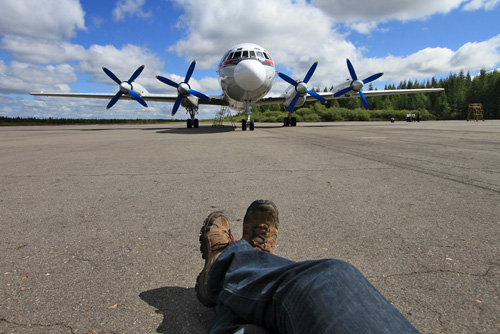

And finally ... the boarding stairs driver could even be won for a second promising position. Fantastic!

After we had besieged the elegant aircraft for no less than half an hour, we deployed to the terminal for a Q&A session with a part of the five-person crew (in addition to them, a complete second crew accompanied us on the trip!). The Captain (left) was answering our questions, while the young radio operator eagerly translated, clearly enjoying the opportunity to practice his English. We learned that this IL-18 with which we had flown, was a specially well-equipped variant, because she had been used for presidential flights, and that Air Koryo has enough spare parts to keep the IL-18 flying for another ten years (and fully intends to do so).


Now you have to endure another small round of sightseeing: Next to the airport we were picked up by a bus and embarked on a trip through dense alpine forests and barren plains…

...to Mount Paektu, located on the Chinese border. The 2’744 meter high stratovolcano is the highest mountain in the entire Korean peninsula, and has always been regarded by Koreans as an important spiritual place. It is also of great importance to the North Korean propaganda, as it’s said to have been the base of Kim il-sung's guerilla resistance against the Japanese and the birth place of the second leader, Kim jong-il. For this reason, it can be seen glorified on posters and murals all over the country – but even the natural live version is breathtaking!

A rumbling old funicular (for once unfortunately not made in Switzerland) took us to just below the summit, where we enjoyed a picnic we had brought from Pyongyang as well as the fabulous views

Well rested we then set out to climb to the very top, which we reached in a 20-minute walk. From there, we had a superb view of the amazingly beautiful crater lake Chonji ("Heaven Lake") and all the way to the Chinese side of the crater rim.

View during the descent; in the distance (below the somewhat larger cloud almost exactly in the middle of the photo) the runway of Samjiyon Airport can be spotted

By cable car (which is apparently broken more often than it works) we went back down again…

... and continued our journey to the next attraction, following never-ending narrow forest roads through no man's land – where, to our astonishment, we passed countless groups of marching soldiers, while we had no idea where they could possibly come from or be headed out here. It felt almost like artificial intelligence people aimlessly walking the streets of some computer game!


The destination of our painfully bumpy 90-minute ride? A simple log cabin, would you believe it! But of course, it’s not just *any* log cabin, but the one where (according to propaganda) the “Dear Leader” Kim Jong-il was born in (soviet records state he was born near Khabarovsk though). Admittedly, the hut doesn’t look much older than 10 years – and the position of doors and windows differs significantly compared to the propaganda picture, too. But like so many times on this trip: Just listen to their story, and take it with a smile.


Exhausted from the flight and the rough rides in the bus we retired for the evening in a remote hotel. This was not quite as luxurious as the Koryo Hotel, but still pretty okay. The mild electric shocks when washing your hands and the non-functioning toilet ensured a bit of welcome adventure to write home about though. The in-room amenities didn’t bother us too much though, since we spent the longer part of the night at the bar anyway.
Relatively tired, we continued our sightseeing mission the next morning, but we were treated with a real gem! The Rimyongsu Falls, topped by a beautiful pavilion.

Of course we couldn’t leave without seeing the Samjiyon Grand Monument, which commemorates the guerilla war against the Japanese. The bronze statue of the "Great Leader" dominates the area…

...and his soldiers were sculpted so lifelike that you’d think snapping with your fingers is all it takes to make them spring into action!



Then we went for a hearty lunch and some last electric shocks back in our hotel, and finally left for the airport

With no seat reservations anymore, 40 enthusiasts could be observed walking faster and faster as they approached the aircraft, finally running up the stairs, eager to get one of the four coveted window seats in front of the props!
Anyway. I let the others go first, and contented myself with a seat behind the wing. After a seemingly endless takeoff run (even the old IL isn’t immune to high altitude!) we climbed out very flat and headed for Pyongyang.

The flight was uneventful, and after half an hour we were back again in the extended final approach path to Pyongyang – the landing gear long extended already

Enjoying the last seconds in the air

Hello Pyongyang!

While we were taxiing to the terminal, our guide announced over the P/A system that he had a little surprise for us. After we’d parked, a bus picked us up and brought us to the “famous” Ilyushin-14 other tour groups had spotted standing on the apron. According to information provided by a representative of Air Koryo, she was given to the “Great Leader” by Stalin in 1955, and Kim il-sung flew her himself.

The Il-14 is reported to have been flown the last time in 1987. While she’s obviously not airworthy anymore, she is kept in impeccable condition, due to her large sentimental value to the country. She is said to be moved to a museum near Pyongyang in 2013.


While the previous tours were allowed to look at the classic from outside, we were the first Western people who were granted access to the inside, too. Here the beautifully furnished cabin:


And finally, passing the desks of radio operator and navigator ...

...we reach the holy office!

While we were gathered around the IL-14, we also had a chance to snap some apron shots: First, our IL-18 being towed back to its parking location made for a great tail parade picture…

…and then, this sleek jet came taxiing by, too!

Riding the Tu-134: A daytrip to Hamhung
The plane pictured above also plays the leading role on the next day: We chartered it for a day trip to the East Coast.

Once again: All aboard! This time we had the plane to ourselves, which made for a more relaxed atmosphere on board.



So we were all quickly seated, and ready for the next adventure. The startup of the Soloviev engines was again a feast for the ears, and 10 minutes later we received the full roar. Takeoff!
(once again a colleague's video of the trip: http://www.youtube.com/watch?v=6K1qutUEJBo )

Shortly after take-off, we turn to the east ...

... and enjoy a few minutes’ cruise through the clouds

Cabin shot: Checked!

Same thing applies to detailed shots of the interior

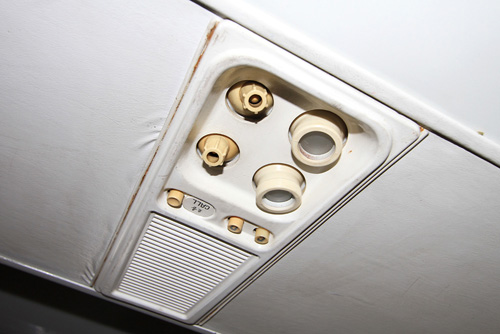
Shortly after, we were in the final approach to the airport of Sondok near Hamhung on North Korea's east coast. Taking photos during the approach was officially not allowed (probably due to some military installations on the ground), so it had to be done in secret…

The usual procedure followed: Before vacating the plane, everybody got a quick peek inside the cockpit!

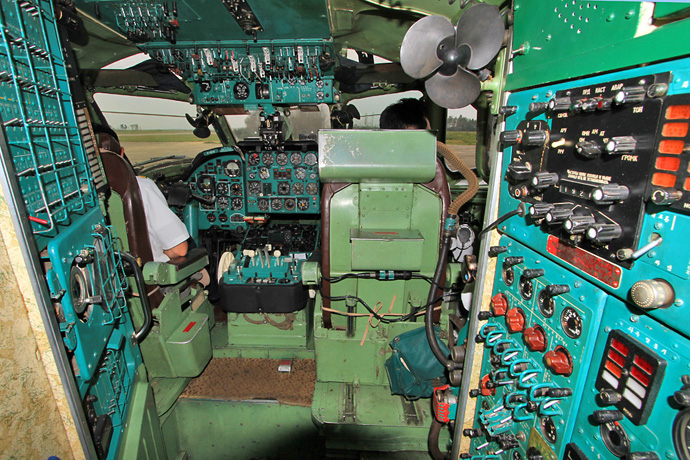

Our sleek beauty during a short sunny spell...

... and in some more detailed shots. Here, too, we had plenty of time to satisfy our photographic hunger


Yet another bus was waiting, and it took us to a somewhat strange sight: a fertilizer plant. Both the group and the guides – we already got along really well by then – couldn’t wait for the touristic highlight of our visit, and mimicked feverish anticipation. Et voilà – it’s super nice here, eh?

I do not know exactly what is coming out of the chimney there, but the whole place was drenched in a terrible smell of ammonia that left you hardly daring to breathe.


After all, the visit at least yielded a few "typical" North Korea pictures: That’s how I’d imagined the whole country to be before my visit: gray, dark, rough and full of propaganda.


After walking through a noisy machine hall, the hour-long visit was thankfully completed…

...and we could turn to more beautiful destinations!

Unfortunately there was not much time for splashing in the water: Lunch was already waiting in the dining room of the adjacent beach resort. On a side note, despite all the raw and strange foods we were eating, none of them caused any stomach troubles – it was the salami pizza in Pyongyang’s Italian restaurant on the same eve that got some of us though :)

The trip to Hamhung was originally planned to include an overnight stay at the beach resort. However, since our Tu-134 was needed to fly a Chinese tour group the next day, we had to return again the same afternoon. Not that I minded too much! So, buckle up again, off we go!

The sun shyly peeked through the clouds by now, but since bleed air and air conditioning were shut off for the takeoff – a common procedure on those flights – the dirty and scratched windows fogged up quickly, taking away most of the good views

Our Indian class clown made for some entertainment in the air, and was quick to replace the Air Koryo Flight Attendants with his own service concept – a very effective one at that!

After less than half an hour we were already back in familiar surroundings, the northern approach corridor of Pyongyang

Just as we taxied to our stand, we could see how one of the hardly used IL76 was towed for an engine test. A good sign for our last big highlight, which was to take place after a rest-day filled with sightseeing in the capital.
The big day: Flying in the IL-76's cargo hold
On Friday, the birthday of two tour members, the long awaited highlight was finally taking place: Flying on the Il-76 and the An-24. Yipee! And as if this hadn’t been enough, we were blessed with decent weather after two days of rain and overcast clouds. Perfect conditions for an unforgettable day!
Originally, two half-hour sightseeing flights around Pyongyang had been planned. Shortly before our departure for Korea, however, we received the information that the administration had banned such scenic flights without any apparent reason. Our tour operator didn’t just give up and cancel the flights though – he converted them into a round-trip to Sondok and back, at his own cost. This not only left us with more airtime, but also with plenty of good photography opportunities at the more laid-back Sondok airport.
The Il-76 was the means of choice for the outbound leg...

... and sure enough, there she was already waiting for us! Even just to *see* an Il-76 has become a rare highlight in my part of the world. Riding in her belly however is almost unbelievable, and definitely a once in a lifetime experience!

Accordingly excited, the mob stormed the 22-year-young freighter...

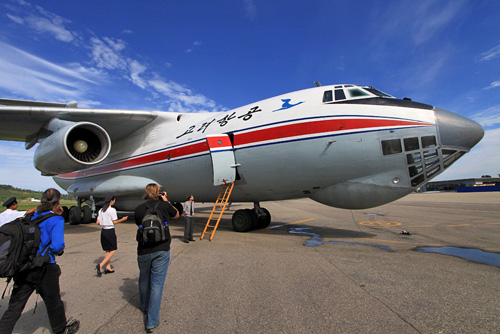
...and immediately took every corner of the huge cargo deck under scrutiny!



A quick "clean shot" of the cargo compartment ....

…and then we’re strapped down on the troop seats and get ready to rumble!
On the right, the Load Master can be observed watching his instruments (and our picnic supplies)


Unfortunately, I wasn’t lucky enough to get one of the four window seats, but even without any view of the outside world, the flight was an absolute highlight! The huge empty cargo space increased the engine noise similar to a cathedral, and when the takeoff thrust was set, we had to take care not to slip backwards on our seats. A real experience!
Luckily, one of the guys at the windows was kind enough to share his video with the world: Definitely recommended! http://www.youtube.com/watch?v=N1hkpo3DSn4
My roommate also took the Il-76 on the way back (while most others rode on the An-24), and was able to obtain the following wing views. Cool!


It didn’t take long till the nose was lowered, we slipped forward on our seats, the landing gear was extended, and after what felt like an eternity, with a loud screech of the 16 main gear tires, we touched down hard. Speeding along the runway was so bumpy that I feared we’d landed on the grass next to it, but finally the reverse thrust kicked in and the howling engines brought us to a halt on the small apron. Here’s a video of mine showing the inside view of the landing.: http://www.youtube.com/watch?v=8ChMMJkgkhY&hd=1
Welcome to Hamhung!

No getting off yet though! First, we embarked on a tour of the maze that is the two-story cockpit. Yes, while the first group in March was lucky just to see the IL76, and the August group was denied visiting the flight deck, we were treated to the full show!
First I went to the lower level - the glass nose, workplace of navigator and observer



And finally, I progressed to the ultimate hotspot! :)

Then the outside shooting began. My friend immediately darted to a well-located photo puddle, and now there were six of us getting dirty lying at the Ilyushin’s feet. But it was so worth it!

It just looks awesome from every angle!


Wow, wow, wow!

A classical shot for the purists out there...

...and a souvenir shot for me and a Swiss colleague!

Nose parade

Finally we retreated to the VIP room inside the terminal to have our picnic - always observed by the great leaders!


In the afternoon we got ready for the flight home - and finally, I was able to settle my bill with the An-24, which had escaped me on an earlier visit to Cuba. Yay!

Calm before the storm when all the crazy people return…

Even though it was clearly overshadowed by the fantastic IL76-ride, I also looked forward to flying aboard the Antonov workhorse!


Before we boarded however, we were treated with watching the IL76 starting up its four engines only a few meters away, and then see it taxi around us and depart for Pyongyang. What a spectacle! Here’s my shaky attempt at recording the show on video!
http://www.youtube.com/watch?v=9wwwk2gkPXk&hd=1
While the Ilyushin was still in sight, the first few already began to run toward the Antonov to secure a good window seat. I could at least grab one with a decent view of the gear and engine, and looked forward to the ride to Pyongyang!

The An-24 really surprised me: The seat pitch was unexpectedly generous after all we’d gone through the last week, and the noise level seemed to be almost as low as in an ATR or an older Dash-8. The only thing to complain about would be the lack of an air-condition, which had us madly fanning around with the few remaining safety cards for the whole lengthy flight.
We say goodbye to the East Coast ...

...enjoy the comparatively long ride (after three jet flights on the same route) by admiring the scenery...


...and are finally being welcomed again by Pyongyang’s northern areas.

Once again, we start our now well-known approach procedure: Quickly wave at the Kyonryong Reservoir lake and then head straight for Rwy 19.

But wait, something's wrong! We are higher than usual, and suddenly a right turn is initiated! Yay, stronger winds from the north make us fly a Visual Circling onto Rwy 01! And I was sitting on the right side to collect the airport view ... :)
Clearly visible in the front is the active runway runway 19/01 (4'000m), then the loooong taxiway including a bridge over the channelled Taedong River, leading to the old and blocked runway 17/35 (3'500 m), and finally, to the apron and terminals. Admittedly a somewhat strange airport layout but oh well - what isn’t strange in this country?

Advantage number two of the circling: A few extra minutes overhead the pretty colourful parcel rice fields! On the right, the airport can be spotted again as we’re due to turn onto the final approach course.

Aaaaand here we are, touchdown on 01!
And yeah, I did indeed switch sides while on final. But seeing the locals *standing* in the connecting corridor behind the cockpit for the whole landing, I assumed it was safe to do so...:-)

Aaaand even here, a cockpit shot was possible! The deep black of the panel appears quite logical, too, after we could smell the cockpit crew lighting up their cigarettes the minute after we touched down! :-)

Even the small turboprop obviously requires a crew of four, so once more there are stations for the radio operator and flight engineer

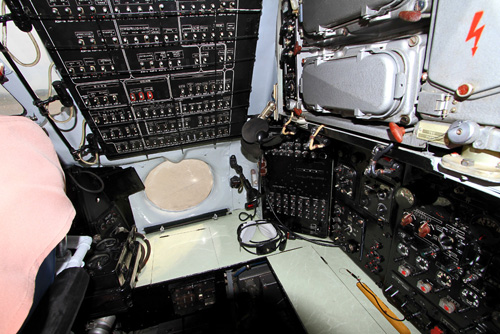
Before we headed back to the terminal to re-unite with the IL76 part of our group, the crew quickly posed for a neat picture in front of their aircraft (also take note of the state-of-the-art passenger bus in the back!)

Overjoyed by the experienced, we were transported back to the city, completed some final sightseeing, and enjoyed one last delicious dinner (while many group members couldn’t wait to leave the Korean cuisine behind and sprint into the first McDonalds on their way, I thoroughly enjoyed it and would’ve loved to taste some more – except for the cute domestic animal starting with d... we once tried in a soup maybe [and no, it wasn't donkey]).
The next morning, the group split up: one part was flying directly to Beijing in order to catch the most modern Air Koryo plane, the Tu-204. It featured an attractive, modern cabin including LCD displays on the ceiling, where a North Korean action movie was shown in a deafening volume. Here are three pictures of my German colleagues – on the large one, Beijing Capital International Airport and its characteristic Terminal 3 can be recognized.


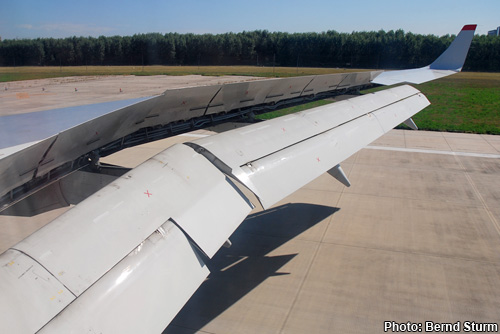
Back to China in the Tu-154
I, however, opted for the "classic" version and was hoping to also get the last missing member of the “old” Air Koryo fleet: the Tu-154. While it is scheduled to carry out the flights to the northern Chinese city of Shenyang just beyond the border, it is quite often replaced with bigger aircraft.
As you can imagine, tensions were rising as we headed to Pyongyang airport for the last time and assembled in the busy departures hall. Which plane would await us on the apron?
Yay, here she is! While we weren’t treated to the Tu-154B (which would have been the oldest flying Tu-154 in the world) but “only" the slightly newer "B-2" version, we were more than happy just to get it!

We got our phones back (finding yours in a heap of shiny black iPhones isn’t the easiest of things, but mine turned out to be the one covered by a myriad of scratches…) and then we were ready for departure. Just the 30-year-old steel rocket (the fastest active civilian aircraft!) needed some time until it was ready and boarding was delayed for 30 minutes.

But then the terminal's sliding doors opened, we boarded the bus, and were brought to the Russian beauty! All hands aboard!
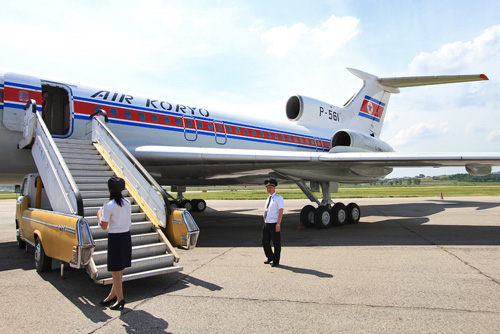
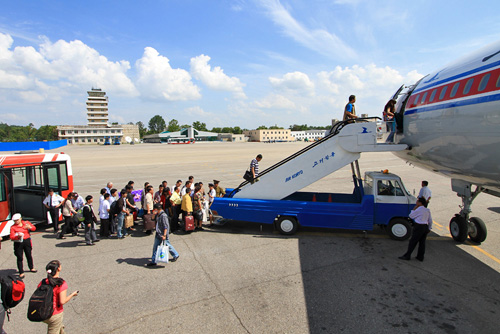
What a great view along the sleek wings, swept back at a 35 degree angle, and our IL-76 in the background!

Soviet-style cabin covered with the typical wallpapers!

One last time we taxi over the Taedong River to the new runway, and finally take to the North Korean skies…!
While the Tu-154M shares its Soloviev D-30 engines with the IL-62 and the IL-76, we were treated to the older and much louder Kuznetsov NK-8s on our Tu-154-B2. What an unbelievable sound – even a bit better than the other jets on the trip!
Here's a video from a friend on the other side of the cabin, Simon de Rudder: http://www.youtube.com/watch?v=dGshjr29cQE&hd=1

Turning left after departure: Bye bye pretty rice fields!

Finally, the flight attendants served the long-awaited Koryo Burger. An apparent contradiction, if you bought propaganda postcards displaying crushed US soldiers just the day before. But only till you remember that it was actually Kim Jong-il who invented the hamburger, and not the evil capitalists!


The short flight was a walk in the park for the fast Tupolev, and before we know it, we are already in the descent towards Shenyang.

Ten minutes later, the Tu-154 is fully established on final approach to runway 06, and we enjoy the last moments aboard this exotic plane before re-entering the ordinary, boring, modern world!

As soon as we had touched down on the runway of Shenyang and the howling reversers had been silenced again, the sound of 160 phones finding a connection and downloading a week’s load of messages instantly brought us back to reality.
Conclusion
Well, what impression remains of North Korea? First and foremost, I was very positively surprised by the openness towards us photographers and enthusiasts.
The Tour
David, the young owner of Juche Travel Services, has achieved a lot in a very short time, thanks to lots of hard work and tremendous organizational skills. The program was very packed, but this also allowed us to get the most out of our limited time in this fascinating country. More or less everything went as planned, except for the Mi-8 flight which was cancelled as the choppers had obviously been transferred to another company shortly before our visit. Apart from that, our guides were fast to improvise and provide a smooth experience for us even when stuff didn’t go according to plan. But they also did their best to tailor the itinerary to our needs, and didn’t hesitate to throw out some sights so we could take more pictures of our airplanes on sunny days.
Both inside the aircraft as well as elsewhere in the country, I had always felt safe and very well looked after. I can therefore truly recommend the tour to anyone who is interested in old airplanes and not afraid to visit a not so normal destination. Several tours have already been announced for the next year, however there are rumours that the IL-62 won’t be used on scheduled international flights anymore and would have to be chartered at higher costs instead. I’m sure that as soon as he receives more detailed information, David will publish it on the Juche Travel website, www.juchetravelservices.com .
The country
Well, this is of course a double-edged sword. I readily admit that what we got to see of North Korea has positively surprised me and had a lasting impression. It was a fascinating exeperience that I wouldn't wanna miss. And so I come to the conclusion that from a purely and superficially touristic point of view, the country is very well worth the trip: You see attractive landscapes, impressive buildings and immerse yourself in a world that can’t be found anywhere else on the planet, which will definitely broaden your horizon. All this at a pretty high level of comfort and safety, which is why I can definitely recommend the destination to almost anybody out there. Provided of course you are willing to arrange yourself with the special travel conditions for a week (almost no communication with the outside world, continuous monitoring and observation, unorthodox beliefs and opinions, lots of propaganda sites).
That is the one, as I said superficially-tourist side. You will definitely only be seeing what the government wants you to see, and this differs quite a lot from the actual life in the country.
In the end, you have to ask yourself if you can live with this contradiction. I, for myself, decided that I can. And yes, I would not hesitate to go back to North Korea. In addition to the tour cost, I spent about the equivalent of a North Korean annual salary for attractions, shows and souvenirs alone - not only in the rich Pyongyang area but also in the outlying regions. And even if this money goes to the regime people first – even those rich party members will have to buy groceries at one point, and finally the money does end up with the poor farmers or craftsmen. I am convinced that my visit hasn’t had a negative effect on any of the people, and maybe even a positive one for some. That's all I need. I am also convinced that it can only be conducive to a further opening of the country if more and more tourists get to see North Korea with their own eyes. It will not only help their understanding of the country. It also makes it harder for the regime to keep up its façade, and it also shows the locals that there is actually an outside world of people like you and me, who aren’t so mean after all! :-)

